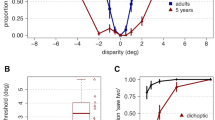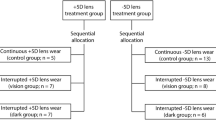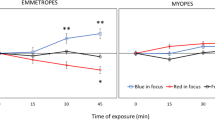Abstract
The influence of visual experience on ocular development in higher primates is not well understood. To investigate the possible role of defocus in regulating ocular growth, spectacle lenses were used to optically simulate refractive anomalies in young monkeys (for example, myopia or nearsightedness). Both positive and negative lenses produced compensating ocular growth that reduced the lens-induced refractive errors and, at least for low lens powers, minimized any refractive-error differences between the two eyes. These results indicate that the developing primate visual system can detect the presence of refractive anomalies and alter each eye's growth to eliminate these refractive errors. Moreover, these results support the hypothesis that spectacle lenses can alter eye development in young children.
This is a preview of subscription content, access via your institution
Access options
Subscribe to this journal
Receive 12 print issues and online access
$209.00 per year
only $17.42 per issue
Buy this article
- Purchase on Springer Link
- Instant access to full article PDF
Prices may be subject to local taxes which are calculated during checkout
Similar content being viewed by others
References
Charman, W.N. Optics of the human eye. in Vision and Visual Dysfunction, vol. 1, Visual Optics and Instrumentation (ed. Charman, W.) 1–20 (CRC Press, Boston, 1991).
Green, D.G., Powers, M.K. & Banks, M.S. Depth of focus, eye size, and visual acuity. Vision Res. 20, 827–835 (1980).
Schaeffel, F., Glasser, A. & Howland, H.C. modation, refractive error, and eye growth in chickens. Vision Res. 28, 639–657 (1988).
Schaeffel, F. & Howland, H.C. Mathematical model of emmetropization in the chicken. J. Opt. Soc. Am. A 5, 2080–2086 (1988).
Schaeffel, F., Troilo, D., Wallman, J. & Howland, H.C. Developing eyes that lack accommodation grow to compensate for imposed defocus. Vis. Neurosci. 4, 177–183 (1990).
Irving, E.L., Callender, M.G. & Sivak, J.G. Inducing myopia, hyperopia, and astigmatism in chicks. Optom. vis. Sci. 68, 364–368 (1991);
Irving, E.X., Sivak, J.G. & Callender, M.G. Refractive plasticity of the developing chick eye. Ophthal. Physiol. Opt. 12, 448–456 (1992).
Rohrer, B., Schaeffel, F. & Zrenner, E. Longitudinal chromatic aberration and emmetropizaton: Results from the chicken eye. J. Physiol. 449, 363–376 (1992).
Wildsoet, C.F., Howland, H.C., Falconer, S. & Dick, K. Chromatic aberration and accommodation: Their role in emmetropization in the chick. Vision Res. 33, 1593–1603 (1993).
Hendrickson, P. & Rosenblum, W. Accommodation demand and deprivation in kitten ocular development. Invest Ophthalmol. vis. Sci. 26, 343–349 (1985).
Ni, J. & Smith, E.L. Effects of chronic optical defocus on the kitten's refractive status. Vision Res. 29, 929–938 (1989).
Smith, E.L., Harwerth, R.S. & Crawford, M.L.J. Spatial contrast sensitivity deficits in monkeys produced by optically induced anisometropia. Invest. Ophthalmol. Vis. Sci. 26, 330–342 (1985).
Crewther, S.G., Nathan, J., Kiely, P.M., Brennan, N.A. & Crewther, D.P. The effect of defocusing contact lenses on refraction in cynomolgus monkeys. Clin. vis. Sci. 3, 221–228 (1988).
Chung, K. Critical review: Effects of optical defocus on refractive development and ocular growth and relation to accommodation. Optom. vis. Sci. 70, 228–233 (1993).
Smith, E.L., Hung, L.-F. & Harwerth, R.S. Effects of optically induced blur on the refractive status of young monkeys. Vision Res. 34, 293–301 (1994).
Schaeffel, F. & Howland, H.C. Properties of the feedback loops controlling eye growth and refractive state in the chicken. Vision Res. 31, 717–734 (1991).
Troilo, D. & Wallman, J. The regulation of eye growth and refractive state: An experimental study of emmetropization. Vision Res. 31, 1237–1250 (1991).
Kiorpes, L. & Wallman, J. Does experimentally-induced amblyopia cause hyperopia in monkeys? Vision Res. 35, 1289–1297 (1995).
Schaeffel, F., Howland, H.C. & Farkas, L. Natural accommodation in the growing chicken. Vision Res. 26, 1977–1993 (1986).
Raviola, E. & Wiesel, T.N. An animal model of myopia. New Engl. J. Med. 312, 1609–1615 (1985).
Smith, E.L., Harwerth, R.S., Crawford, M.L.J. & von Noorden, G.K. Observations on the effects of form deprivation on the refractive status of the monkey. Invest. Ophthalmol. vis. Sci. 28, 1236–1245 (1987).
Wallman, J., Gottlieb, M.D., Rajaram, V. & Fugate-Wentzek, L.A. Local retinal regions control local eye growth and myopia. Science 237, 73–77 (1987).
Boothe, R., Dobson, V. & Teller, D. Postnatal development of vision in human and nonhuman primates. Annu. Rev. Neurosci. 8, 495–545 (1985).
Kiely, P.M. et al. A comparison of ocular development of the cynomolgus monkey and man. Clin. vis. Sci. 1, 269–280 (1987).
Gwiazda, J., Thorn, F., Bauer, J. & Held, R. Emmetropization and the progression of manifest refraction in children followed from infancy to puberty. Clin. vis. Sci. 8, 337–344 (1993).
Medina, A. A model for emmetropization: The effect of corrective lenses. Acta. Opthalmol. 65, 565–571 (1987).
Medina, A. A model for emmetropization: Predicting the progression of ametropia. Ophthalmologica 194, 133–139 (1987).
Ingram, R.M., Arnold, P.E., Dally, S. & Lucas, J. tion, squint, and reduced visual acuity after treatment. Br. J. Ophthalmol. 75, 414–416 (1991).
Atkinson, J. Infant vision screening: Prediction and prevention of strabismus and amblyopia from refractive screening in the Cambridge Photorefraction Program. in Early Visual Development, Normal and Abnormal (ed. Simons, K.) 335–348 (Oxford Univ. Press, New York, 1993).
Crawford, M.L.J. & von Noorden, G.K. Concomitant strabismus and cortical eye dominance in young rhesus monkeys. Trans. Ophthalmol. Soc. U.K. 99, 369–374 (1979).
Schaeffel, F., Farkas, L. & Howland, H.C. Infrared photoretinoscopy. Appl. Opt. 26, 1505–1509 (1987).
Howland, H.C. Optics of photoretinoscopy: Results from ray tracing. Am. J. Optom. Physiol. Optics 62, 621–625 (1985).
Author information
Authors and Affiliations
Rights and permissions
About this article
Cite this article
Hung, LF., Crawford, M. & Smith, E. Spectacle lenses alter eye growth and the refractive status of young monkeys. Nat Med 1, 761–765 (1995). https://doi.org/10.1038/nm0895-761
Received:
Accepted:
Issue Date:
DOI: https://doi.org/10.1038/nm0895-761
This article is cited by
-
Additive effects of narrowband light and optical defocus on chick eye growth and refraction
Eye and Vision (2023)
-
The age-related pattern of inner retinal thickening is affected by myopia development and progression
Scientific Reports (2022)
-
Electroretinogram responses in myopia: a review
Documenta Ophthalmologica (2022)
-
Genome-wide analysis of retinal transcriptome reveals common genetic network underlying perception of contrast and optical defocus detection
BMC Medical Genomics (2021)
-
Factors predicting long-term changes in refraction after lamellar keratoscleroplasty in children with limbal dermoids
Eye (2021)



